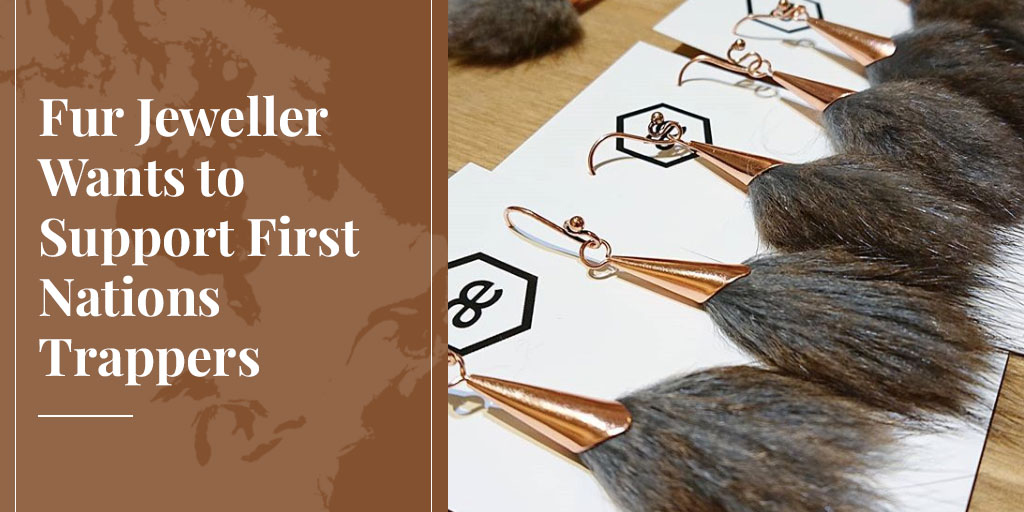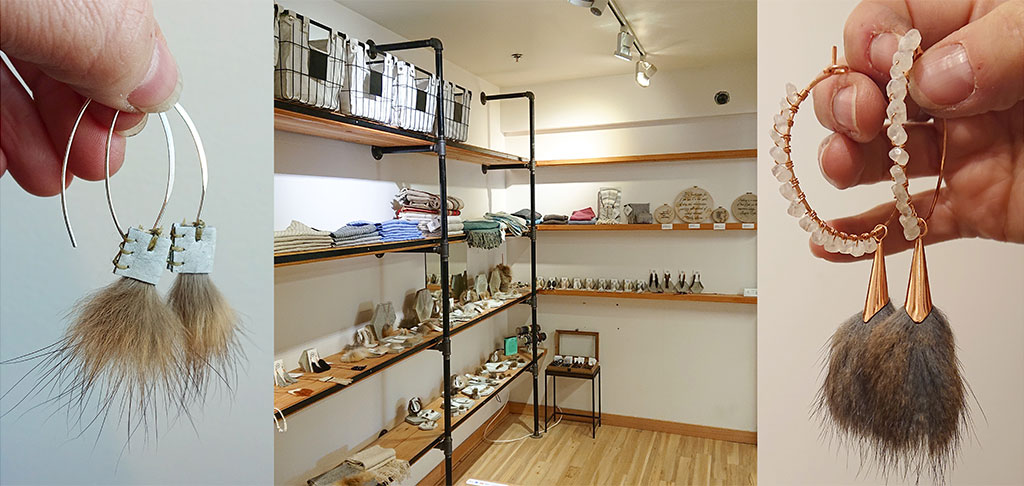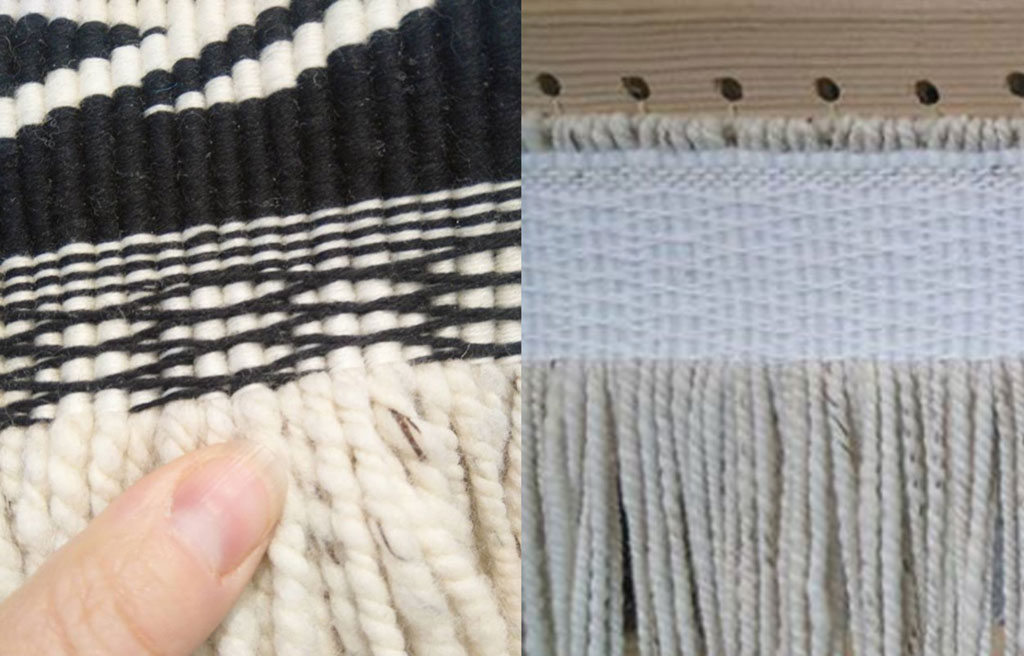
In this age of mass-produced, imported goods, textile artist and jewellery designer Vanessa Ægirsdóttir belongs to a growing band of people who want more of the benefits of commerce going to producers of raw materials, and specifically in her case to Canada’s First Nations trappers. While her family name reflects her Icelandic heritage, this artisan is Canadian born and bred, and currently lives in Whitehorse, Yukon. Together with her partner, Tlingit trapper George Bahm, her mission is to generate more economic returns for trappers of the Kwanlin Dün First Nation and the Ta’an Kwäch’än Council, in whose traditional territory they reside.
TruthAboutFur: Last year you opened a boutique in Whitehorse selling mainly fur jewellery. The Yukon is known for hats and mittens made by First Nations artisans. Why not do the same? Are you trying to create a new market?
Vanessa Ægirsdóttir: Our products include scarves, hair scrunchies, bracelets, necklaces, earrings, and rings. We will be growing the line to include housewares and garments in the future. When developing the line, I wasn’t so much trying to create a new market as much as I was looking to enhance an existing one. Yes, the Yukon is known for mukluks, moccasins, mittens and trapper hats, but there was room for me to add a jewellery line and other accessories.
I feel strongly that it is not my place to elbow my way into the traditional fur products market, and there are many extremely skilled makers who are far more qualified than I am to be making these products. When folks inquire with me about having these traditional items made, I forward the contact information of the makers that have opted into being on a referral list that I share. So while I am an agent, I am not a middle man, and we don’t sell their goods in our boutique.
I also know that many of those makers (several of whom are Elders) rely on the income generated from sewing traditional fur and hide garments, and I have absolutely no interest in taking that away from them. It’s a matter of respect.

TAF: How do you source your furs?
Vanessa: Preference is given to First Nations trappers when buying our furs. First, I buy all the furs of my partner, George Bahm, then if we need furs that his trapline didn’t produce, we go to his cousins and uncles. If we still need furs, we extend our search to his home community of Teslin and outward from there, always giving priority to First Nations trappers.
TAF: What incentive do trappers have to sell to you, rather than sending their pelts to auction, as is the common practice?
Vanessa: We often pay the same as, if not more than, what is typically obtained through the auction houses. This is a multi-faceted decision.
We want our local trappers to have choices about where their furs go, so by offering to buy the furs instead of them having to send them out, we create an option for them. We want to put more power back into the hands of the trappers. Normally, trappers can sell at auction for an unknown (often disappointing) price, or keep the furs and make finished goods themselves — but this is something not everyone can do due to skill, time, or interest.
We also want to help our trappers make informed decisions about which furs to target, and how to invest in capital assets for their trapline operations. Knowing the current values of furs at the outset of the trapping season gives the trappers the choice with regard to what species to target and in what quantities.
Also, in our experience, it is rewarding for the trappers to see how the furs are being used, which is not an experience many are familiar with because furs sent to auction are never seen again.
“More than Just Harvesting Fur”

TAF: So your motivation is not just to build a successful business for yourself. Tell us about your larger vision.
Vanessa: Incentivising our First Nations trappers to sell their furs to us is not my main intention. More than that, I want their trapping to be sustainable and profitable.
Having spent only part of one winter out on the trapline with my partner, I have merely glimpsed a fraction of the beauty and teachings that await on the trapline. But I know that this traditional practice, with its skill, stories and lessons, will be lost if the wild fur industry continues as it is. My hope is to protect the importance of what is out on the trail, in the quiet of a fresh snowfall, so that future generations of fur harvesters can reconnect with their ancestors and the teachings that have endured for thousands of years. Trapping is so much more than just harvesting fur.
It is from this perspective that I might play a small part in an act that builds bridges and relationships between myself, as a non-Indigenous person, and the First Nations trapping community.
SEE ALSO: “‘Trapping is beautiful’ says proud Cree Robert Grandjambe.”
Cultural Immersion Through Weaving

TAF: You have sought to immerse yourself in First Nations culture, and in particular the textiles aspect. But you are also mindful that you yourself are non-Indigenous. Tell us about your journey. Has it been easy?
Vanessa: In addition to working with fur, I am also a Ravenstail weaver. This ancient form of weaving predates the more commonly known Chilkat, and is similar to basket weaving. It originated on the Pacific West Coast with the First Nations (Tlingit, Haida and Tsimshian, among others) who wove and traded Ravenstail robes long before contact. I learned this weaving method from Lily Hope whose mother, Clarissa Rizal, was a master weaver.
I have been warmly welcomed into the weaving community, which is comprised almost exclusively of First Nations weavers. Because of the teachings I’ve been given and the protocols that have been shared with me, in addition to my own skill and cultural awareness, I am allowed to do this weaving work. That’s not to say it has been without question and even upset some members of various First Nations communities. However, we try to use these interactions to inform and to dialogue with those posing questions and expressing concern, and are able to explain the special nature of the permissions given to me to be welcomed into the weaving community. This extends to my relationship with the fur and hide-maker community.
But make no mistake, I am aware that I am a non-Indigenous maker, and I don’t for a minute pretend to be First Nations. I am a guest, and it is a privilege to be welcomed into these various circles of knowledge. I treasure that deeply and take pains to preserve that.
Adding Value to Furs
TAF: So how do you see the current state of trapping in the Yukon? Presumably all is not well, or you wouldn’t be striving for change.
Vanessa: There are around 300 to 400 trapping licenses currently issued by the Yukon Department of Environment, of which I guess fewer than half are held by First Nations trappers, mostly operating on traplines that have been in their families for generations.
What I see is that most trappers, regardless of their indigeneity, are limited in how to add value to their furs. We have the Yukon Trappers Association, which works with trappers of all backgrounds to get their furs to market. They make tools, traps, scent, and boards available for purchase, and also hold workshops. The YTA will batch furs from several trappers and send them out for tanning, which is not a service that is otherwise readily available in the area. Aside from individual makers (traditional or otherwise), there aren’t local manufacturing or design facilities that are taking the furs and producing Yukon-made fur garments.
Many First Nations trappers continue to produce finished goods from their furs like mitts and hats, but as is the case with most producers, the supply chain favours the final seller and not the producer of the materials or the finished goods. If these makers have an established clientele, they are positioned to make a reasonable income, but for those who rely on retail vendors to get their products in front of consumers, their work is shockingly under-valued. For example, it’s common for a maker of moccasins (smoke- and brain-tanned moose hide, beaver fur, and beadwork) to receive only $100 from a retail store owner, regardless of the innumerable hours spent in production.
While there may be a limit to what the market will bear in terms of the final retail price of such goods, it is seldom the maker who is receiving the majority of the money for the product being sold. We’re working to improve that balance.
***
SEE ALSO:
“Fur jewellery shop works to raise awareness about Indigenous culture”, Yukon News, Jan. 24, 2019.
“Yukon artist and Tlingit trapper create stunning jewelry”, Broadview, Feb. 13, 2019.
***
To learn more about donating to Truth About Fur, click here.










